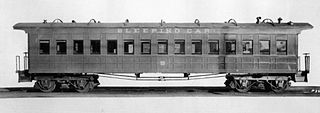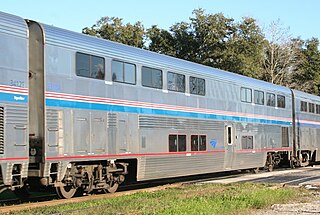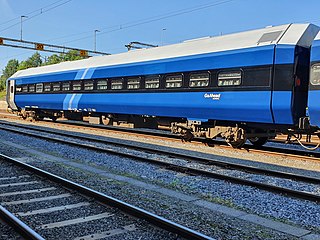
The sleeping car or sleeper is a railway passenger car that can accommodate all passengers in beds of one kind or another, for the purpose of sleeping. George Pullman was the American innovator of the sleeper car.

First class is the most luxurious and most expensive travel class of seats and service on a train, passenger ship, airplane, bus, or other system of transport. Compared to business class and economy class, it offers the best service and most comfortable accommodation.
A couchette car is a railway carriage conveying non or semi-private sleeping accommodation.

In United States railroad terminology, a troop sleeper was a railroad passenger car which had been constructed to serve as something of a mobile barracks for transporting troops over distances sufficient to require overnight accommodations. This method allowed part of the trip to be made overnight, reducing the amount of transit time required and increasing travel efficiency.

A passenger railroad car or passenger car, also called a passenger carriage, passenger coach, or passenger bogie is a railroad car that is designed to carry passengers. The term passenger car can also be associated with a sleeping car, a baggage car, a dining car, railway post office and prisoner transport cars.

The Venice Simplon-Orient-Express (VSOE) is a private luxury train service from London to Venice and other European cities. It is currently owned by Belmond.

City Night Line, abbreviated CNL, was a train category of German railway company Deutsche Bahn for overnight passenger train services between Germany and neighbouring European countries. In late 2015, Deutsche Bahn announced that it planned to terminate all night train services in December 2016, and this plan was implemented on 11 December 2016. The service on some CNL routes was replaced by ÖBB Nightjet services.
A twinette is a sleeping-berth compartment for two persons in a train. The term "twinette" is in common use only in Australia and New Zealand ; thus the double-berth compartments described here are those found in trains in Australia or New Zealand.

A roomette is a type of sleeping car compartment in a railroad passenger train. The term was first used in North America, and was later carried over into Australia and New Zealand. Roomette rooms are relatively small, and were originally generally intended for use by a single person; contemporary roomettes on Amtrak, however, include two sleeping berths.

The TÜVASAŞ 2000, more commonly known as TVS2000, is a series of intercity railcars built by TÜVASAŞ for the Turkish State Railways between 1993 and 2005. They were built in order to revive TCDD's failing image in the early 1990s, for use on the Capital Express. Today they are the most common railcars in Turkey.

NSB WLAB-2 or WLAB2 is a class of twenty sleeping cars built by Strømmens Verksted for the Norwegian State Railways (NSB). They serve as the sole sleepers in Norway, being used on the Bergen Line, Dovre Line, Nordland Line and Sørlandet Line. Each car features fifteen compartments, which can each be utilized with a single or twin bunk configuration. The carriages have a unique octagonal shape, are 27 meters long and weigh 48 tonnes.

The Swan 48 Frers, also called the Swan 48-2 and the Swan 48-2 Frers, is a Finnish sailboat that was designed by Germán Frers as a blue water cruiser-racer and first built in 1995.
The Swan 77 is a Finnish sailboat that was designed by Germán Frers as a blue water cruiser-racer and first built in 1992.

The Catalina 18, formerly known as the Capri 18, is a trailerable American sailboat that was designed by Frank Butler and Gerry Douglas and first built in 1985.

The Seaward 22 is an American trailerable sailboat that was designed by Nick Hake and first built in 1985.
The Windrose 5.5 is an American trailerable sailboat that was designed by W. Shad Turner as a pocket cruiser and first built in 1977.
The ETAP 30i is a Belgian sailboat that was designed by French designers Mortain & Mavrikios, as a cruiser and first built in 1995.
The Lancer 25 is an American trailerable sailboat that was designed by W. Shad Turner as a cruiser and first built in 1975.
The Sovereign 23 and Sovereign 24 are a family of American trailerable sailboats that was designed by Arthur Edmunds as cruisers and first built in 1981.
The Swan 108 is a Finnish maxi yacht that was designed by Germán Frers as a blue water cruiser-racer and first built in 2023. The exterior design is by Lucio Micheletti and the interior design is by Misa Poggi.















